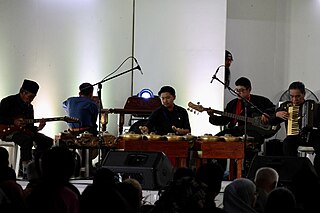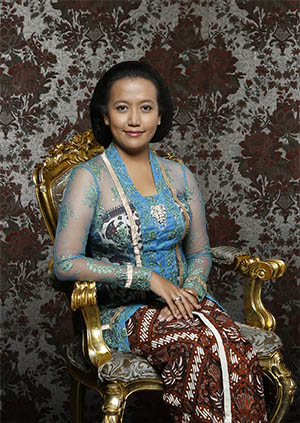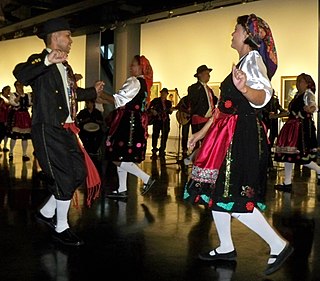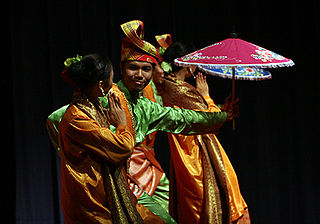
The Malay Peninsula is located in Mainland Southeast Asia. The landmass runs approximately north–south, and at its terminus, it is the southernmost point of the Asian continental mainland. The area contains Peninsular Malaysia, Southern Thailand, and the southernmost tip of Myanmar (Kawthaung). The island country of Singapore also has historical and cultural ties with the region.

Music of Malaysia is the generic term for music that has been created in various genres in Malaysia. A great variety of genres in Malaysian music reflects the specific cultural groups within multiethnic Malaysian society: Malay, Indonesian, Arabic, Chinese, Indian, Dayak, Kadazan-Dusun, Bajau, Orang Asli, Melanau, Kristang and others.

Malays are an Austronesian ethnoreligious group native to eastern Sumatra, the Malay Peninsula and coastal Borneo, as well as the smaller islands that lie between these locations. These locations are today part of the countries of Malaysia, Indonesia, the southern part of Thailand, Singapore and Brunei Darussalam.

The Riau Islands is a province of Indonesia—not to be confused with neighbouring Riau Province from which the Riau Islands Province were separated in 2002. The capital of the province is Tanjung Pinang, while the largest city is Batam. It shares a maritime border with Riau and Jambi to the west, Bangka Belitung Islands to the south, Singapore to the northeast, Malaysia and West Kalimantan to the east, and Vietnam and Cambodia to the north. It comprises a total of 2,028 islands scattered between Sumatra, Malay Peninsula, and Borneo including the Riau Archipelago. Situated on one of the world's busiest shipping lanes along the Malacca Strait and the Natuna Sea, the province shares water borders with neighboring countries such as Singapore, Malaysia, and Brunei. The Riau Islands also have relatively large potential mineral resources and energy, as well as marine resources.

Brunei is a southeast Asian country located on Borneo between the states of Sabah and Sarawak which are part of Malaysia. There is a wide array of native folk music, and dance. Brunei shares some Cultural perspectives and links with the countries of Southeast Asia such as Malaysia, Singapore, Indonesia, Thailand, and the Philippines. The strong Islamic influence means that dance performances and music are somewhat restricted.

Malacca City is the capital city of the Malaysian state of Malacca, in Melaka Tengah District. It is the oldest Malaysian city on the Straits of Malacca, having become a successful entrepôt in the era of the Malacca Sultanate. The present-day city was founded by Parameswara, a Sumatran prince who escaped to the Malay Peninsula when Srivijaya fell to the Majapahit. Following the establishment of the Malacca Sultanate, the city drew the attention of traders from the Middle East, South Asia, and East Asia, as well as the Portuguese, who intended to dominate the trade route in Asia. After Malacca was conquered by Portugal, the city became an area of conflict when the sultanates of Aceh and Johor attempted to take control from the Portuguese.
Dondang Sayang originated in Malacca sometime in the 15th century, influenced by traditional Portuguese folk music. It is a traditional Malay form of entertainment where Baba and Nyonya singers exchange extemporaneous Malay Pantun (poetry), in a lighthearted and sometimes humorous style. The singers are normally accompanied by a violin, two Malay rebana (drums), and a tetawak (gong). These instruments are often supplemented by other available instruments, most notably, accordions, flutes, or an additional violin.

The Culture of Malaysia draws on the varied cultures of the different people of Malaysia. The first people to live in the area were indigenous tribes that still remain; they were followed by the Malays, who moved there from mainland Asia in ancient times. Chinese and Indian cultural influences made their mark when trade began with those countries, and increased with immigration to Malaysia. Other cultures that heavily influenced that of Malaysia include Persian, Arabic and British. The many different ethnicities that currently exist in Malaysia have their own unique and distinctive cultural identities, with some crossover.

A kebaya is an upper garment traditionally worn by women in Southeast Asia, notably in Brunei, Indonesia, Malaysia, Singapore, and Southern Thailand. It is also worn in parts of southern Philippines and Cambodia.

The Kristang are a creole and indigenous ethnic group of people of primarily Portuguese and Malay descent, with substantial Dutch, British, Jewish, Chinese and Indian ancestry. They are based mostly in Malaysia, Singapore and Australia, the last being due to significant emigration in the second half of the twentieth century. People of this ethnicity also have, besides Malay and Portuguese, Dutch ancestry due to intermarriages, which is common among the Kristang. In addition, due to persecution by the Portuguese Inquisition in the region, a lot of the Jews of Malacca assimilated into the Kristang community. The creole group arose in Malacca between the 16th and 17th centuries, when the city was a port and base of the Portuguese Empire. Today the Malaysian government classifies them as Portuguese-Eurasians; in Singapore, they are primarily known as Kristang. Today, elements of Kristang culture and identity, especially the Kristang language, which is classified as critically endangered by the UNESCO Red Book of Endangered Languages, are currently undergoing cultural and language revitalisation in both Malaysia and Singapore. The Kabesa or leader of the community worldwide and in Singapore is the Kristang Singaporean science fiction writer and linguist Kevin Martens Wong, while the current Regedor or Headman of the Portuguese Settlement of Malacca, the original, geographical, cultural and spiritual centre of the Malacca Portuguese identity, is Oliver Lopez.
The corridinho is a form of Portuguese folk dance, namely in the Algarve region. The origin of the dance itself is unclear and believed older, although it gained popularity in the 1800s. The name derives from correr, to run which partly describes this type of dance. The dance was performed in a round in the open air. The oldest musical instruments recorded were small flutes or fifes (pífaro) and harmonicas, (harmónica) until the accordion was implemented and dominated ever since.

Pakaian is the term for clothing in Malaysia's national language. It is referring to things to wear such as shirts, pants, shoes etc. Since Malaysia is a multicultural nation: Malay, Chinese, Indian and hundreds of other indigenous groups of Malay Peninsula and Borneo, each has its own traditional and religious articles of clothing all of which are gender-specific and may be adapted to local influences and conditions. Previously, traditional clothes were worn daily. However, by excluding Baju Melayu, Baju Kurung many are now only worn on special occasions such as marriage ceremonies and cultural events.

The Portuguese Settlement is a settlement area of Ujong Pasir in Malacca City, Melaka Tengah District, Malacca, Malaysia, which serves as a home for the Kristang people. The Kristang people are a Malaysian ethnic group with mixed Portuguese and Malay heritage, originating from the time of the Portuguese rule in Malacca.

The Acehnese are an indigenous ethnic group native to Aceh, Indonesia on the northernmost tip of the island of Sumatra. The area has a history of political struggle against the Dutch colonial rule. The vast majority of Acehnese people are Muslims. The Acehnese people are also referred to by other names such as Lam Muri, Lambri, Akhir, Achin, Asji, A-tse and Atse. Their language, Acehnese, belongs to the Aceh–Chamic group of Malayo-Polynesian of the Austronesian language family.

Bruneian Malays are a native Malay ethnic group that lives in Brunei, the federal territory of Labuan, the southwestern coast of Sabah and the northern parts of Sarawak. The Bruneian Malays are a subgroup of the larger ethnic Malay population found in the other parts of the Malay World, namely Peninsular Malaysia and the central and southern areas of Sarawak including neighbouring lands such as Singapore, Indonesia and Southern Thailand, having visible differences especially in language and culture, even though they are ethnically related to each other and follow the teachings of Islam. All Bruneian Malays who are born or domiciled in East Malaysia even for generations before or after the independence of the states of Sabah and Sarawak from the British Empire through the formation of Malaysia in 1963 are also considered Malaysian Malays in the national census and were in the same status like the Malaysian Malays domiciled in Peninsular Malaysian states and the central and southern parts of Sarawak. They are also defined as a part of the Bumiputera racial classification together as a subgroup within the Malaysian Malay ethnic population along with the Kadazan-Dusuns, Orang Ulu, Ibans, Malaccan Portuguese, Muruts, Orang Sungai, Bajau, Suluks and the Malaysian Siamese.

Joget is a traditional Malay dance that originated in Malacca in the colonial era. It was influenced by the Portuguese dance of Branyo which is believed to have been spread to Malacca during the spice trade. In Malacca, joget dance is better known as Chakunchak. The dance is one of the most popular folk dances in Malaysia that is normally performed by couples in cultural festivals, weddings and other social functions. Joget gained popularity among the Malay community in Singapore after its introduction in 1942.

Kelantanese Malays are a sub-ethnic group of Malays native to the state of Kelantan, Malaysia as well as in Northern Terengganu. The Kelantanese Malays are closely related to Thai Malays and Terengganuan Malays in neighbouring Terengganu, these two Malay sub-ethnic groups shared historical, cultural and linguistic as well as kinship ties with the Kelantanese Malays. Kelantanese Malays form 94% of Kelantan's population, which makes them the largest ethnic group in Kelantan and around 150,000 in Besut, Terengganu.

Terengganu Malays, are a Malay ethnic group native to the state of Terengganu, on the east coast of Peninsular Malaysia. Besides Terengganu, they can also be found in the neighbouring states of Pahang and Johor. The descendants of Terengganu Malays can also be found in the Anambas Islands in Indonesia. As of 2010, it is estimated that the population of Terengganuan Malays is around 1.1 million people, and they form 94% of Terengganu's population, making them the dominant ethnic group in the state.
Dance in Malaysia encompasses dance traditions from many different ethic origins. Malay dances include Dance Dramas, Court Dramas, and Folk Dances. Other dances come from Javanese, Orang Asli, Portuguese, Siamese, Dayak, Moro, and Chinese traditions. This article includes a list of dances, organised by ethic origin.

Traditional Malaysian art is primarily composed of Malay art and Bornean art, is very similar with the other styles from Southeast Asia, such as Bruneian, Indonesian and Singaporean. Art has a long tradition in Malaysia, with Malay art that dating back to the Malay sultanates, has always been influenced by Chinese, Indian and Islamic arts, and also present, due to large population of Chinese and Indian in today's Malaysian demographics.
















